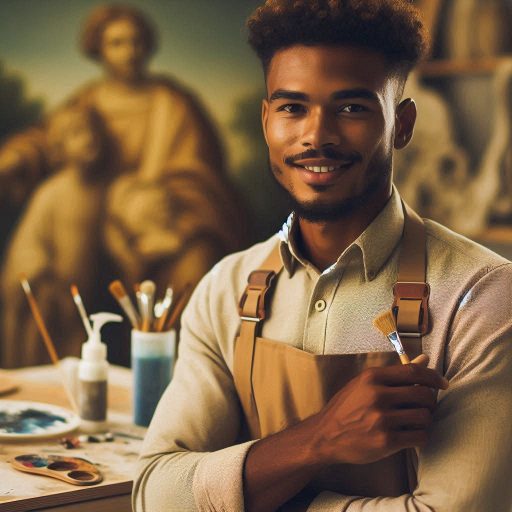Introduction
Art conservators and art restorers play vital roles in the preservation of artworks.
Both professions aim to protect and maintain art, but their approaches and goals differ significantly.
Understanding these differences is crucial for appreciating how artworks are cared for and preserved.
Art conservators focus on the long-term preservation of artworks.
They analyze and document the condition of art pieces.
Their work often involves scientific methods to stabilize and prevent further deterioration.
Conservators work with materials and techniques that ensure the artwork‘s longevity.
Their primary goal is to preserve the original state of the art, minimizing any intervention that might alter it.
On the other hand, art restorers concentrate on repairing and rejuvenating artworks.
They address damage such as tears, cracks, or discoloration.
Restoration involves reconstructing missing parts and blending in with the original artwork.
Restorers use various techniques to make these repairs look seamless while maintaining artistic integrity.
Both roles are essential in the art world.
Art conservators ensure that artworks remain in good condition for future generations.
Art restorers help to bring damaged works back to their former glory.
This blog post will explore the key differences between these two professions.
We will highlight their distinct roles and contributions to the field of art preservation.
Definition and Roles
What art conservators do
Art conservators are professionals who specialize in the preservation and maintenance of art.
They focus on preventing deterioration and ensuring the longevity of artworks.
What art restorers do
On the other hand, art restorers are experts who are skilled in repairing and restoring artworks that have been damaged or degraded over time.
Transform Your Career Today
Unlock a personalized career strategy that drives real results. Get tailored advice and a roadmap designed just for you.
Start NowTheir primary goal is to revive the original beauty of the piece.
How their roles differ in the art world
- Focus: Conservators prioritize preventive care, while restorers concentrate on repairing existing damage.
- Techniques: Conservators use non-invasive methods to stabilize and protect artworks, while restorers employ more hands-on techniques to restore the visual integrity of pieces.
- Training: Conservators typically have a background in art history, chemistry, and conservation science, while restorers often have fine arts training with a focus on restoration techniques.
- Approach: Conservators take a holistic approach, considering the historical context and materials of the artwork, while restorers focus on visual aesthetics and resolving specific damage.
- Decision-making: Conservators make decisions based on research, ethics, and professional guidelines, while restorers rely on their artistic judgment and technical skills.
- Career Paths: Conservators often work in museums, galleries, or conservation labs, while restorers may operate independently or within restoration studios.
Overall, while both art conservators and art restorers aim to preserve and restore artworks, their approaches, techniques, and training differ significantly, making each profession unique in the art world.
Read: Day in the Life of an Art Conservator/Restorer
Training and Education
Art conservators and art restorers both work to preserve and maintain artworks, but they have distinct roles and responsibilities within the field of art conservation.
One of the key differences between these two professions lies in the training and education required to become a qualified professional in each role.
Educational requirements for art conservators
Art conservators typically need to have a bachelor’s degree in a related field, such as art history, studio art, or conservation studies.
Many art conservators also pursue graduate degrees in art conservation or a related discipline.
These programs often include coursework in art history, chemistry, conservation techniques, and practical hands-on experience working with different types of artworks.
In addition to formal education, art conservators may also participate in internships or apprenticeships with experienced professionals to gain practical skills and knowledge in the field.
These hands-on experiences are invaluable in preparing conservators to work on a wide range of art objects and materials.
Educational requirements for art restorers
Art restorers, on the other hand, may have a slightly different educational background.
While some may also have degrees in art history or studio art, art restorers often focus more on developing technical skills related to the restoration and repair of artworks.
This can involve specialized training in painting techniques, sculpture restoration, or conservation science.
Art restorers may learn their craft through hands-on apprenticeships or training programs that focus specifically on restoration techniques.
These programs may include coursework in art conservation, surface cleaning, color matching, and other technical skills necessary to restore artworks to their original condition.
Contrasts in the training programs for each profession
Overall, the training programs for art conservators and art restorers are designed to provide professionals with the skills and knowledge needed to preserve and restore artworks effectively.
However, the emphasis in each program may differ, with art conservators focusing more on the conservation and preventive care of artworks, while art restorers concentrate on the technical aspects of repairing and restoring damaged pieces.
Regardless of their specific roles, both art conservators and art restorers play critical roles in the preservation of our cultural heritage.
By understanding the distinctions in their training and education, we can better appreciate the expertise and dedication that these professionals bring to their work in safeguarding artworks for future generations.
In essence, the paths to becoming an art conservator or art restorer may vary, but the ultimate goal remains the same: to protect and maintain the beauty and integrity of our artistic heritage for years to come.
Transform Your Career Today
Unlock a personalized career strategy that drives real results. Get tailored advice and a roadmap designed just for you.
Start NowRead: Top Art Conservation Programs in the USA
Tools and Techniques
When it comes to the tools and techniques used by art conservators and art restorers, there are some key differences that distinguish the two professions.
Let’s take a closer look at the tools commonly used by each, as well as the different techniques employed in preserving and restoring artworks.
Tools commonly used by art conservators
- Microscopes: Used to examine artworks at a microscopic level to identify damage or deterioration.
- Chemical tests: Used to analyze the composition of materials in artworks and assess their stability.
- Consolidants: Adhesives used to stabilize flaking or loose paint layers without altering the original artwork.
- Humidifiers: Used to regulate the humidity levels in storage or display spaces to prevent damage to artworks.
- Soft brushes and sponges: Used for gentle cleaning of artworks without causing abrasion or damage to the surface.
Tools commonly used by art restorers
- Palette knives: Used for removing old varnish or paint layers during the restoration process.
- Brushes: Various types and sizes of brushes are used for retouching and applying new paint to damaged areas.
- Heating tools: Used to soften old adhesives or varnishes for removal without damaging the underlying layers.
- Fillers and pigments: Used to fill in losses or damaged areas and carefully match colors for seamless repairs.
- UV lights: Used to detect previous restoration work or determine the age of varnishes on artworks.
Different techniques employed by each profession
Art conservators focus on preserving the original integrity of an artwork through minimal intervention and reversible treatments.
They use techniques such as surface cleaning, consolidation, and environmental control to prevent further deterioration.
On the other hand, art restorers are tasked with restoring artworks to their original appearance by repairing damages and addressing aesthetic concerns.
They use techniques like filling losses, retouching, and varnishing to seamlessly integrate repairs into the artwork.
While both art conservators and art restorers share a common goal of preserving and maintaining artworks for future generations, the tools and techniques they employ are tailored to their specific roles in the conservation and restoration process.
Read: Must-Visit Art and Design Schools in the USA

Focus and Specialization
Art conservators and art restorers have different areas of focus and specialization that impact how they approach their work on art pieces.
Areas of Focus for Art Conservators
Conservators primarily focus on preventive conservation, which involves taking measures to mitigate potential damage to art pieces before it occurs.
This includes proper handling, storage, and environmental control to prevent deterioration.
Research is another key area of focus for conservators.
They study the materials and techniques used in creating art pieces to better understand their composition and how they may change over time.
Areas of Focus for Art Restorers
Restorers, on the other hand, specialize in the physical restoration of art pieces.
This includes surface cleaning to remove dirt, grime, or varnish that may have accumulated over time and obscured the original details of the artwork.
Paint retouching is another critical specialization for restorers.
They carefully match paint colors to fill in areas of lost or damaged paint, ensuring that the restoration seamlessly blends with the original work.
These different areas of focus and specialization impact how conservators and restorers approach their work on art pieces.
Conservators prioritize preventive measures to ensure the long-term preservation of artworks, while restorers focus on physically restoring the aesthetic qualities of the piece through cleaning and painting techniques.
Transform Your Career Today
Unlock a personalized career strategy that drives real results. Get tailored advice and a roadmap designed just for you.
Start NowRead: Career Paths for Graduates in Art and Design
Ethics and Guidelines
Ethical considerations for art conservators
- Art conservators must respect the original intent of the artist.
- They should prioritize the preservation of cultural heritage.
- Being transparent about the methods used in conservation.
- Avoiding over-restoration that alters the original artwork.
- Respecting the integrity of the artwork throughout the process.
Ethical considerations for art restorers
- Restorers must disclose any interventions made on the artwork.
- Respecting the historical and aesthetic value of the piece.
- Using reversible techniques to ensure future conservation.
- Documenting all processes to provide historical context.
- Avoiding personal biases that may influence restoration decisions.
Importance of adhering to professional guidelines in both professions to maintain the integrity of artworks
- Professional guidelines ensure consistency and standards in conservation.
- Following guidelines helps in preserving the authenticity of artworks.
- It builds trust with clients and art institutions.
- Guidelines provide a framework for ethical decision-making.
- Upholding professional standards contributes to the longevity of cultural heritage.
See Related Content: The Best Online Courses for Aspiring Illustrators
Collaborations
How art conservators collaborate with curators, artists, and art historians
Art conservators rely on curators to provide historical and contextual information about the artwork.
Curators guide conservators in understanding the artist’s intentions, techniques, and materials used in creating the piece.
Similarly, art historians play a vital role in providing insights into the historical significance of the artwork.
Their research helps conservators make informed decisions about the conservation process, ensuring that the artwork’s historical value is preserved.
Collaboration with artists is beneficial for art conservators to gain insights into the artist’s creative process.
Artists can offer valuable information about their techniques, materials, and intended aesthetic, which aids conservators in making decisions about the preservation and restoration of the artwork.
How art restorers collaborate with conservation scientists, art technicians, and framers
On the other hand, art restorers collaborate with conservation scientists to analyze the materials and techniques used in the artwork.
Conservation scientists conduct scientific analyses to determine the best course of action for the restoration process.
Art technicians play a crucial role in executing the restoration process.
They have the technical skills and expertise required to carry out delicate treatments on the artwork under the guidance of the restorer.
Collaboration with framers is essential for art restorers to ensure that the artwork is properly framed and displayed.
Framers provide expertise in choosing appropriate framing materials and techniques to protect the artwork from environmental factors.
Importance of working together to ensure the longevity and preservation of artworks
Working together as a team is essential for conservators and restorers to achieve successful outcomes in preserving artworks.
By collaborating effectively, these professionals can combine their expertise and knowledge to ensure the long-term preservation of cultural heritage.
Discover More: How to Present Your Industrial Design Work Effectively
Preservation vs. Restoration
When it comes to the world of art conservation and art restoration, there are key differences that distinguish these two practices.
One of the main distinctions lies in their goals and approaches towards preserving and reviving artworks.
Let’s delve into the differences between preservation and restoration in the field of art.
Transform Your Career Today
Unlock a personalized career strategy that drives real results. Get tailored advice and a roadmap designed just for you.
Start NowArt conservation focuses on the preservation and maintenance of artworks to halt their deterioration and ensure their longevity.
The primary goal is to prevent further damage and decay, utilizing methods that are reversible and minimally invasive.
Differences between the goals of art conservation and art restoration
Art conservation aims to safeguard the original materials and integrity of an artwork.
Art restoration, on the other hand, focuses on repairing and enhancing the aesthetic appearance of the artwork.
Conservators prioritize the stability and authenticity of the piece, while restorers concentrate on visual appeal.
Why preservation is crucial in the field of art conservation
Preservation is essential in art conservation as it ensures that the original intent and historical significance of an artwork are maintained.
By employing preventive measures such as climate control, proper handling, and storage conditions, conservators can prolong the lifespan of artworks and prevent irreversible damage.
How restoration plays a role in reviving the aesthetics of artworks
While preservation focuses on preventative care, restoration involves more active interventions to improve the appearance of artworks.
This may include cleaning, structural repairs, and in-painting to bring back the original vibrancy and visual impact of the piece.
In a nutshell, both art conservation and art restoration play vital roles in the preservation and maintenance of cultural heritage.
While conservation focuses on protecting the authenticity and historical significance of artworks, restoration aims to revitalize their visual appeal and aesthetics.
By understanding the differences between these two practices, we can appreciate the intricate balance between preserving the past and breathing new life into artistic masterpieces.
Discover More: How to Get Inspired for Jewelry Design
Conclusion
Key Differences
Art conservators focus on preventive care, documentation, and research.
They ensure the long-term preservation of artworks and historical artifacts.
Art restorers, on the other hand, are concerned with repairing damages.
They work to restore an artwork to its original appearance.
Conservators use scientific methods to analyze materials and conditions.
Restoration Techniques
Restorers perform physical treatments such as cleaning, filling, and inpainting.
They aim to recreate the artist’s intended visual impact.
Transform Your Career Today
Unlock a personalized career strategy that drives real results. Get tailored advice and a roadmap designed just for you.
Start NowConservators, however, focus on stabilizing and protecting an artwork.
They use reversible methods to prevent further deterioration.
Both professions require a deep understanding of art history and chemistry.
Complementary Roles
Conservators and restorers often collaborate closely on complex projects.
Conservators provide the knowledge and guidance for long-term preservation.
Restorers bring the technical skills needed to repair and rejuvenate artworks.
Together, they work to ensure the longevity and aesthetic appeal of cultural heritage.
Their roles are mutually dependent and essential in the field of art conservation.
Art conservators focus on preservation, while art restorers specialize in restoration.
Both professions play crucial roles in maintaining and restoring cultural heritage.
It’s important to appreciate the efforts made by conservators and restorers alike.
Through their collaboration, they ensure that artworks are protected for future generations to enjoy.




